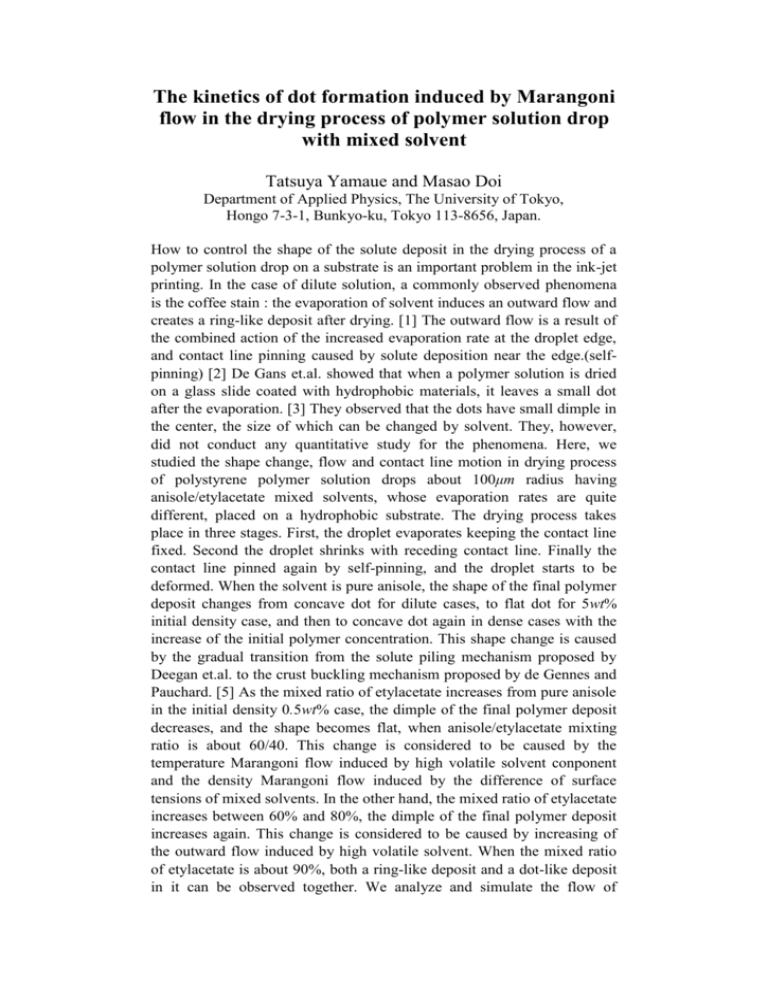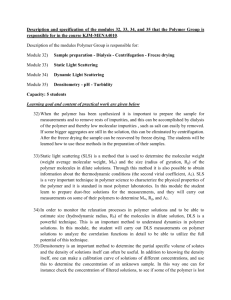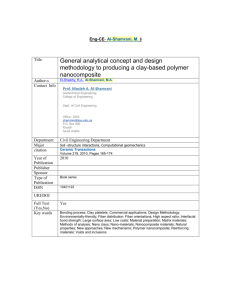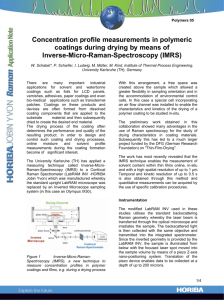solvent rev
advertisement

The kinetics of dot formation induced by Marangoni flow in the drying process of polymer solution drop with mixed solvent Tatsuya Yamaue and Masao Doi Department of Applied Physics, The University of Tokyo, Hongo 7-3-1, Bunkyo-ku, Tokyo 113-8656, Japan. How to control the shape of the solute deposit in the drying process of a polymer solution drop on a substrate is an important problem in the ink-jet printing. In the case of dilute solution, a commonly observed phenomena is the coffee stain : the evaporation of solvent induces an outward flow and creates a ring-like deposit after drying. [1] The outward flow is a result of the combined action of the increased evaporation rate at the droplet edge, and contact line pinning caused by solute deposition near the edge.(selfpinning) [2] De Gans et.al. showed that when a polymer solution is dried on a glass slide coated with hydrophobic materials, it leaves a small dot after the evaporation. [3] They observed that the dots have small dimple in the center, the size of which can be changed by solvent. They, however, did not conduct any quantitative study for the phenomena. Here, we studied the shape change, flow and contact line motion in drying process of polystyrene polymer solution drops about 100μm radius having anisole/etylacetate mixed solvents, whose evaporation rates are quite different, placed on a hydrophobic substrate. The drying process takes place in three stages. First, the droplet evaporates keeping the contact line fixed. Second the droplet shrinks with receding contact line. Finally the contact line pinned again by self-pinning, and the droplet starts to be deformed. When the solvent is pure anisole, the shape of the final polymer deposit changes from concave dot for dilute cases, to flat dot for 5wt% initial density case, and then to concave dot again in dense cases with the increase of the initial polymer concentration. This shape change is caused by the gradual transition from the solute piling mechanism proposed by Deegan et.al. to the crust buckling mechanism proposed by de Gennes and Pauchard. [5] As the mixed ratio of etylacetate increases from pure anisole in the initial density 0.5wt% case, the dimple of the final polymer deposit decreases, and the shape becomes flat, when anisole/etylacetate mixting ratio is about 60/40. This change is considered to be caused by the temperature Marangoni flow induced by high volatile solvent conponent and the density Marangoni flow induced by the difference of surface tensions of mixed solvents. In the other hand, the mixed ratio of etylacetate increases between 60% and 80%, the dimple of the final polymer deposit increases again. This change is considered to be caused by increasing of the outward flow induced by high volatile solvent. When the mixed ratio of etylacetate is about 90%, both a ring-like deposit and a dot-like deposit in it can be observed together. We analyze and simulate the flow of polymer solute in the evaporation process of polymer solution drops using the competetion model of the Marangoni flow and the outward flow, each model is based on Hu-Larson model [6], and the shape change in the evaporation and gelation process after selfpinning using the stress diffusion coupling model of gel dynamics based on the two fluids model of polymer and solvent. [7] [1] R. D. Deegan, et. al. : Nature 389, 827 (1997) : Phys. Rev. E62, 756 (2000) : Phys. Rev. E61, 475 (2000). [2] M. D. Haw, M. Gillie and W. C. Poon, Langmuir 18, 1620 (2002). [3] B. J. de Gans and U. S. Schubert : Langmuir 20, 7789 (2004). [4] L. Pauchard, et. al. : Europhys. Lett 62, 897 (2003) : Phys. Rev. E68, 052801 (2003) : Langmuir 20, 5138 (2004). [5] T. Kajiya, E. Nishitani,T. Yamaue,M. Doi : Phys. Rev. E73, 11601 (2006). [6] H. Hu and R. G. Larson : Langmuir 21, 3963 (2005) : Langmuir 21, 3972 (2005). [7] T. Yamaue and M. Doi : Phys. Rev. E70, 011401 (2004) : J. Chem. Phys.122 084703 (2005).











